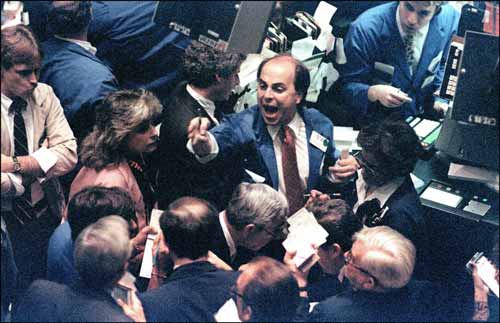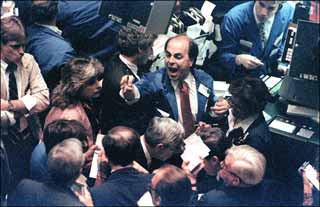What is the Meaning of Par Value?
Actual market price for stock shares can differ significantly from their par value.
The term par value applies to both (1) shares of stock companies issue and sell, and (2) bonds that companies, governments, and other entities issue.
Par value has different meanings in each case, however.
Par Value for Stock Shares
When a company issues new stock shares, par value is the nominal, or officially stated worth of a stock share just before investors begin buying shares. However, as investors start buying shares, the actual price investors pay can and often does rise above par. The funds above par value the issuing companies receive are called "additional paid-in capital," or "contributed capital."
The term "par" came into use as a way for companies to assure the market they will sell no shares below par (so that no one can receive favorable treatment).
Not surprisingly, owners who already have significant shareholdings take a keen interest in first-day share price bidding and buying. Rising share prices mean their holdings increase in value as well.
Par value has little real relevance for accounting because a stock’s market value (and the amount for which the company can sell it) can be entirely different from par value. Nevertheless, companies keep separate Balance sheet. listings for:
- Funds they receive as the par "component" of share issue sales
- Funds they receive "in excess" of par."
These two sums appear in separate lines on the Balance sheet under Owner's Equity. (See Exhibit 2, below, for example).
Par Value for Bonds


Par value for a bond, or face value, is the amount that the issuing company or government entity promises to repay the bondholder on a specific date (maturity> date). A so-called "$100 Bond" has a par value of $100, meaning the bondholder will receive $100 at maturity in addition to any interest earnings.
Explaining Par Value in Context
Sections below show how firms set a par value for new stock shares, and how par value contributes to Owners Equity on the Balance sheet. The term par value appears in context with other accounting and finance terms, including the following:
Contents
Setting Par Value for Stock Shares
How Do Firms Choose the Par Value for the IPO?
Facebook, for instance, made its initial public offering on the NASDAQ exchange on 18 May 2012. For several days before the IPO, analysts and the financial media engaged in intense speculation, trying to predict the initial price. Analyst estimates for initial "price" ran from $26 to $45. Market analysts outside the company speculated on the likely price, while company "insiders" discussed and debated the optimal initial price. The actual figure selected reflected company consideration of:
- The company's initial capitalization target.
- The number of public shares to be offered and the resulting ownership position of the initial owners.
- Predictions of share price changes, once the shares were on the market.
In brief, companies chose an initial share price they believe will meet objectives in all three areas. The goal is to achieve active first-day trading that does not disappoint the original owners, market analysts, or the new investors hoping to "get in on the ground floor" with shares that will continue to increase in value.
Par Value Meaning After Shares Are on the Market
When a company makes its initial public offering (IPO) of stock shares, investors and analysts watch the relationship between initial offering price (par value) and the actual market price dynamics over the first few days of trading. A sharp rise in market price above initial offering price signals strong investor confidence in the company's future. A sharp decrease in market price indicates the opposite.
In the final hours before trading in Facebook shares began, Facebook announced an initial share price of $38.00. In the first hours of trading, the share price rose as high as $45.00. By market close the first day, however, that was down to $38.23, just above the initial value. One week after the IPO, the share price on the open market had fallen to $26.81. The result was that the IPO met and exceeded Facebook's initial capitalization goals ($16 billion), but left significant investors uneasy and uncertain about prospects for share price growth.
The par value concept came into use as a vehicle for companies to announce, before an initial public offering, they would sell no shares below a certain price (par value). The intent was to assure potential investors that no one—including those inside the company—could buy at a "more favorable price."
For publicly traded shares, the difference between share par value and market price can become large, as the company succeeds or fails, and as the business cycle moves through its phases.
Par Value in Balance Sheet Equity
Accounting for Par Value
Business firms issue and sell stock shares to raise funds, of course. Funds acquired in this way are immediately funds that the firm owns outright. Proceeds of new share sales, in other words, become part of Balance sheet Owners Equity.
To understand how stock share par value and actual selling price contribute to Equity, consider first the Owners Equity section near the bottom of the simple Balance sheet in Exhibit 1:
| ASSETS | 22,075 | ||
|---|---|---|---|
| LIABILITIES OWNERS EQUITY Contributed Capital Retained Earnings Total Owners Equity Total Liabilities & Equities |
9,439 3,698 |
8,938 13,137 22,075 |
Where Are the Sources of Owners Equity?
Profit-making companies in private industry usually define the highest level business objective as follows: Increase Owner Value.
In practice, business firms pursue this objective by earning profits. After a successful period, firms can increase owner value by paying dividends directly to shareholder owners. And, they can increase owner value by keeping some or all of the period's profits as retained earnings. Note that Balance sheets such as Exhibits 1 and 2 report the total retained earnings from across the firm's history.
Retained earnings, in turn, are one of two ways the firm can build equity—the value of resources the firm owns outright. The other approach for increasing Equity is to take in Contributed capital (Paid-in Capital). Thus:
- Retained earnings build equity with funds earned in normal operations.
- Contributed capital adds to "equity" funds investors pay directly to purchase new shares. Contributed capital, therefore, does not come from regular business earnings.
For more on the role of retained earnings in building equity, see the articles (1) Statement of Retained Earnings and (2) Owners Equity.
The Role of Par Value in Contributed Capital
After public share sales begin, the par value concept serves only to recognize the price initially set by the company. To show the role of par value in equity reporting, consider a simple stock-issue example and also the Balance sheet in Exhibit 2.
Example: The directors and officers of Grande Corporation decide to issue 10,000 new shares of common stock, at a par value of $1 per share. Suppose also that in the firm's public offering of the same stock shares, investors bid the actual share price up above par, so that by the end of the offering day, the 1,000 new shares have sold at an average price of $3. As a result, Grande has raised $3,000 of contributed capital from the new share sales.
Note that the $3,000 new contributed capital will impact two Contributed Capital lines on the Balance sheet, not one. Firstly, Grande will add $1,000 to the value of the Common Stock line, recognizing the par value received for 1,000 shares. Secondly, Grande will add $2,000 to the Equity line Contributed Capital "in Excess" of Par.
In brief, the Contributed capital "line" of Exhibit 1 becomes a Contributed Capital Section in a more detailed Balance Sheet, usually including three line items, as follows:
- Preferred stock: Preferred share par value received for shares when originally issued.
- Common stock: Common share par value received for shares when originally issued.
- Contributed capital more than par: Funds received for shares sold by the issuing company directly to investors, who bought shares at a price higher than par.
Exhibit 2, below, shows a more detailed version of the Exhibit 1 Balance sheet, with contributed capital items.
| ASSETS Current Assets Cash Short-term investments Accounts receivable Notes receivable short-term Inventories Prepaid exp, insurance, def taxes Total Current Assets Long-Term Investments and Funds Property, Plant & Equipment Intangible Assets Other Assets Total Assets |
1,369 137 1,832 20 5,986 265 |
9,609 1,460 9,716 1,222 68 22,075 |
|
|---|---|---|---|
| LIABILITIES Current Liabilities Long-Term Liabilities Total Liabilities |
3,464 5,474 8,938 |
||
| OWNERS EQUITY Contributed Capital Preferred stock Common stock Contributed capital excess of par Total Contributed Capital Retained Earnings Total Owners Equity |
3,798 4,184 1,457 |
9,439 3,698 |
13,137 |
|
Total Liabilities and Equities |
22,075 |
Solution Matrix Ltd® 292 Newbury St Boston MA 02115 USA
Phone +1.617.849.8478 • Contact Form • Privacy Policy • About Us • Sitemap
Terms of Service • Refunds • Customer Service • Safety & Security
Copyright © 2004–2024 by Solution Matrix Ltd • All Rights Reserved

